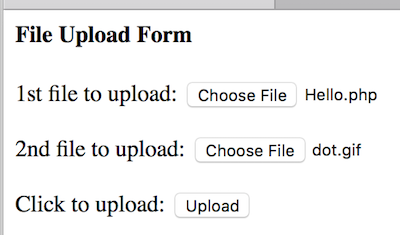PHP Tutorials - Herong's Tutorial Examples - v5.18, by Herong Yang
File Upload Web Form
This section provides a tutorial example on how to write Web form to upload files. type='file' attribute of the 'input' displays 'Choose File' button for user to select a local file to upload.
To manage file uploads with PHP scripts, you need to build a Web form for users to file, select and submit files from their local computers. Here are some guidelines on building file upload forms:
1. Using <form method="POST" ...> to ensure that uploaded files are included in the HTTP request body.
2. Using <form enctype="multipart/form-data" ...> to ensure that uploaded files are properly encoded as multiple attachments.
3. Using <input type="hidden" name="MAX_FILE_SIZE" value="nnnnn"/> before any <input type="file" .../> elements to limit the upload file size to the given number of bytes.
4. Using <input type="file" ...> to display a "Choose File" button to allow the user to search and select a local file to upload.
Here is an example of a Web form, file-upload-form.html, for file upload.
<html>
<!-- file-upload-form.html
- Copyright (c) 2009 HerongYang.com. All Rights Reserved.
-->
<body>
<h4>File Upload Form</h4>
<form action="file-upload-handler.php" method="POST"
enctype="multipart/form-data">
<p>1st file to upload: <input type="file" name="file_one"/></p>
<p>2nd file to upload: <input type="file" name="file_two"/></p>
<p>Click to upload: <input type="submit" name="submit" value=Upload></p>
</form>
</body>
</html>
Put the Web form file, file-upload-form.html, to the Apache Web server on the local computer. Then open this form with a Web browser using http://localhost/file-upload-form.html.
Click "Choose File" buttons to select two different files, Hello.php and dot.gif:

See the next tutorial on how to write file-upload-handler.php to received the uploaded files on the Web server.
Table of Contents
Introduction and Installation of PHP
PHP Data Types and Data Literals
Variables, References, and Constants
Expressions, Operations and Type Conversions
Conditional Statements - "if" and "switch"
Loop Statements - "while", "for", and "do ... while"
Function Declaration, Arguments, and Return Values
Interface with Operating System
Introduction of Class and Object
Integrating PHP with Apache Web Server
Retrieving Information from HTTP Requests
Creating and Managing Sessions in PHP Scripts
Sending and Receiving Cookies in PHP Scripts
Controlling HTTP Response Header Lines in PHP Scripts
Functions to Manage Directories, Files and Images
Localization Overview of Web Applications
Using Non-ASCII Characters in HTML Documents
Using Non-ASCII Characters as PHP Script String Literals
Receiving Non-ASCII Characters from Input Forms
"mbstring" Extension and Non-ASCII Encoding Management
Managing Non-ASCII Character Strings with MySQL Servers
Configuring and Sending Out Emails
Managing PHP Engine and Modules on macOS